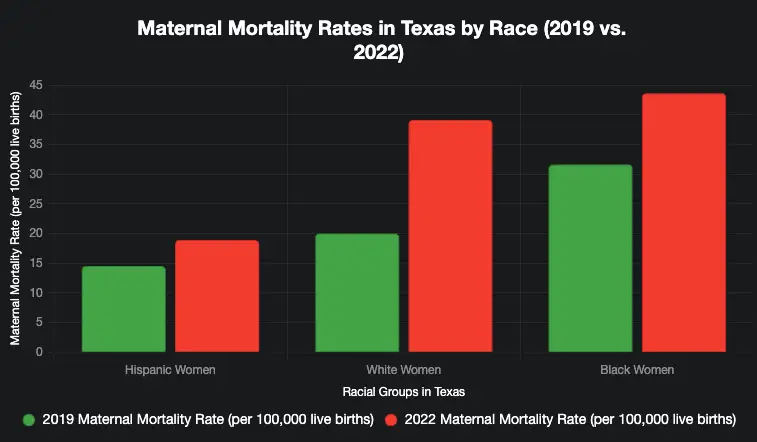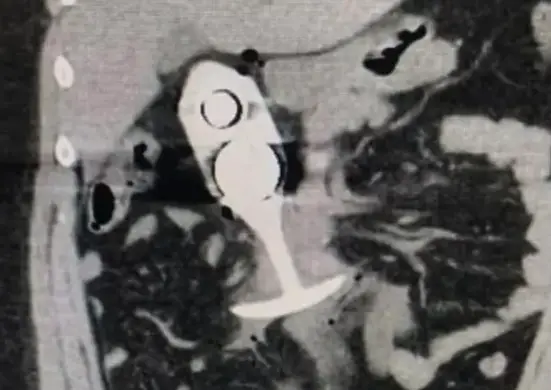Maternal deaths in Texas surge 56% from 2019 to 2022 after 2021 abortion ban, far outpacing 11% nationwide increase

Alarming Surge in Maternal Mortality
Texas has seen a dramatic increase in maternal deaths since the implementation of Senate Bill 8 (SB 8), a near-total abortion ban effective September 2021.
According to an analysis by the Gender Equity Policy Institute (GEPI), maternal mortality rates in Texas rose by 56% from 2019 to 2022.
This far outpaces the national increase of 11% during the same period. The data, drawn from the Centers for Disease Control and Prevention (CDC), points to the ban as a primary driver of this trend.

Racial Disparities in Maternal Deaths
The impact of SB 8 varies across racial groups, exacerbating existing inequities. The table below summarizes the changes in maternal mortality rates per 100,000 live births in Texas from 2019 to 2022:
| Racial Group | 2019 Rate | 2022 Rate | Change |
|---|---|---|---|
| Hispanic Women | 14.5 | 18.9 | +30.3% |
| White Women | 20.0 | 39.1 | +95.5% |
| Black Women | 31.6 | 43.6 | +38.0% |
Hispanic women saw their maternal mortality rate rise from 14.5 to 18.9 per 100,000 live births.
White women experienced a near-doubling of their rate, from 20 to 39.1. Black women, already at higher risk, saw an increase from 31.6 to 43.6.
These disparities highlight how the ban disproportionately affects minority groups, with Black women facing a mortality rate 2.5 times higher than White women in 2023.
Sepsis: A Deadly Consequence
A significant factor in the rising maternal mortality is the increase in sepsis cases, particularly among women experiencing pregnancy loss.
ProPublica’s analysis of hospital discharge data from 2017 to 2023 shows a marked rise in sepsis rates post-ban.
Before SB 8, sepsis rates for second-trimester pregnancy loss ranged from 2.9% to 4.9% annually. After the ban, cases surged:
- 2021: 67 cases (3% rate)
- 2022: 90 cases
- 2023: 99 cases
For women without a fetal death diagnosis, the post-ban sepsis rate reached 6.9%, compared to 3.1%-3.7% pre-ban.
Sepsis, a life-threatening infection response, can lead to organ failure, kidney damage, or death if not treated promptly.
The ban’s restrictions on abortion care, even in medical emergencies, have delayed critical interventions, increasing these risks.
Texas hospitals reported 120 maternal deaths in 2022-2023, up from 79 in 2018-2019—a 33% increase.
Meanwhile, the national maternal mortality rate dropped by 7.5% during the same period, underscoring Texas’s unique trajectory.

Comparison with Other States
The GEPI report compares Texas to other states with and without abortion bans.
In 2023, women in Texas were 1.7 times more likely to die during pregnancy, childbirth, or soon after compared to women in states where abortion remains legal.
Latina mothers in Texas faced nearly triple the risk of maternal mortality compared to those in California, while White mothers faced more than double the risk.
Across states with abortion bans, Black women have a maternal mortality rate of 60.9 per 100,000 live births, compared to 18.2 for both White and Latina women.
Black women in these states are 3.3 times more likely to die than White women, up from 2.2 times in 2019.
Latina and White women in banned states also face higher risks—nearly twice and 1.6 times higher, respectively—than their counterparts in supportive states.
Expert Insights
Experts point to SB 8 as the primary cause of the mortality surge.
Nancy L. Cohen, president of GEPI, stated, “There’s only one explanation for this staggering difference in maternal mortality: Texas’s abortion ban.”
She emphasized that the data aligns with delays in care caused by the ban’s restrictions.
Dr. Alison Gemmill from Johns Hopkins Bloomberg School of Public Health noted, “This might foreshadow what is happening in other states. Texas is basically a year ahead.”
Her research also linked the ban to a 21% increase in infant deaths from accidents in Texas, compared to a 1% national increase.

Broader Context: Infant Mortality
The abortion ban’s impact extends beyond maternal health.
A Johns Hopkins study found that infant mortality in Texas spiked after SB 8, particularly for pregnancies with fetal abnormalities.
This suggests that restrictions on abortion access may force women to carry high-risk pregnancies to term, increasing risks for both mother and child.
Legislative Inaction and Criticism
Despite the evidence, Texas’s response has been limited. The Texas Maternal Mortality and Morbidity Review Committee has chosen not to review death data from 2022 and 2023, focusing instead on more recent years.
This decision has drawn criticism from doctors, lawmakers, and media outlets, including The Texas Tribune, which noted a spike in maternal deaths in 2020 and 2021, even excluding COVID-related cases.
Advocates argue for amending SB 8 to allow exceptions for medical emergencies, while critics of the ban call for a comprehensive review of its impact.
A Cautionary Tale
Texas’s experience serves as a warning for other states with similar abortion restrictions.
As of January 2025, approximately 62.7 million women and girls live under state abortion bans.
The data suggests these policies may lead to higher maternal and infant mortality rates, particularly in states with already strained healthcare systems.
Tulane University research supports this, finding higher maternal mortality in states with restrictive abortion policies.
Voices from the Ground
Personal stories highlight the human toll. While specific cases are not detailed in the data, reports indicate women facing life-threatening complications have been denied timely care due to legal uncertainties surrounding SB 8.
These delays have led to severe outcomes, including sepsis and organ failure, as doctors navigate the ban’s narrow exceptions.
The rising maternal mortality rates in Texas underscore the need for urgent action. Advocates call for policy changes to ensure timely medical interventions, while researchers urge other states to study Texas’s outcomes.
As debates over reproductive rights continue, the data emphasizes the profound impact of abortion bans on women’s lives and health equity.



































